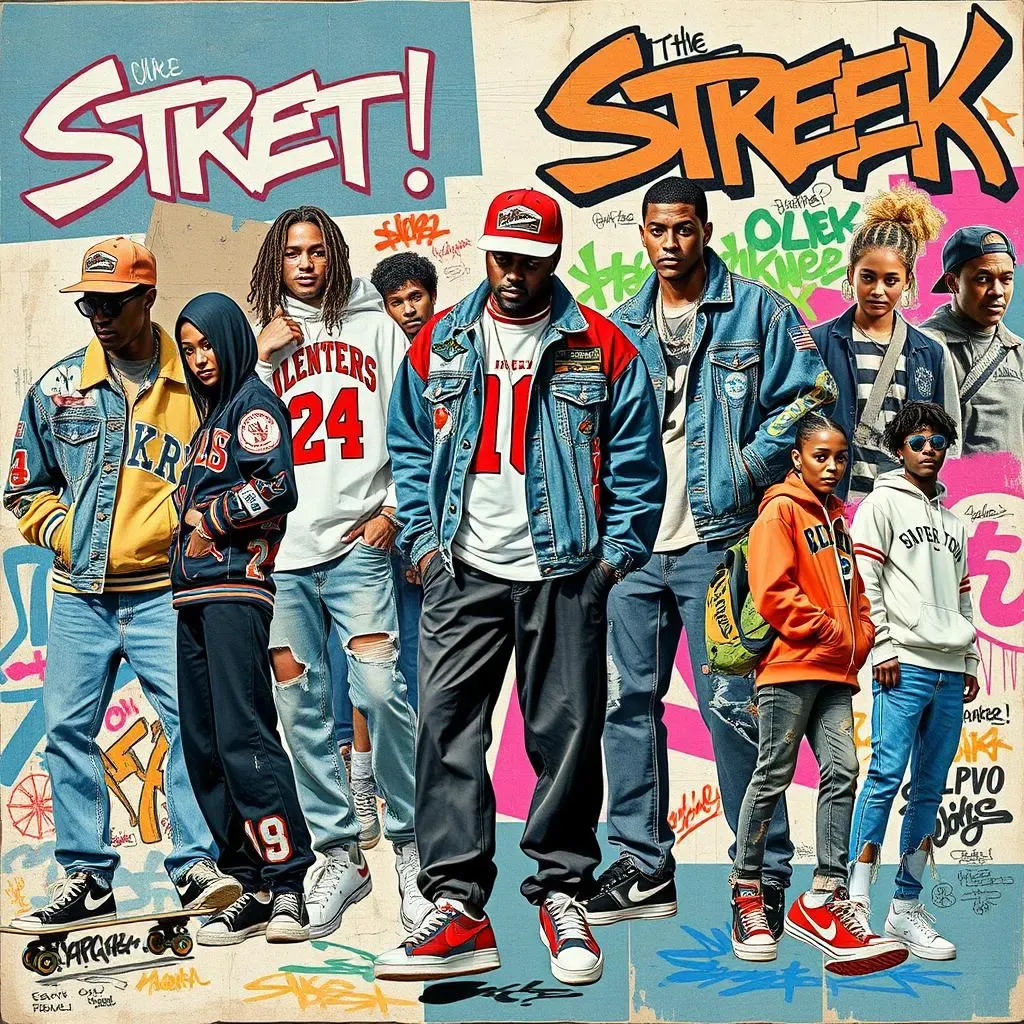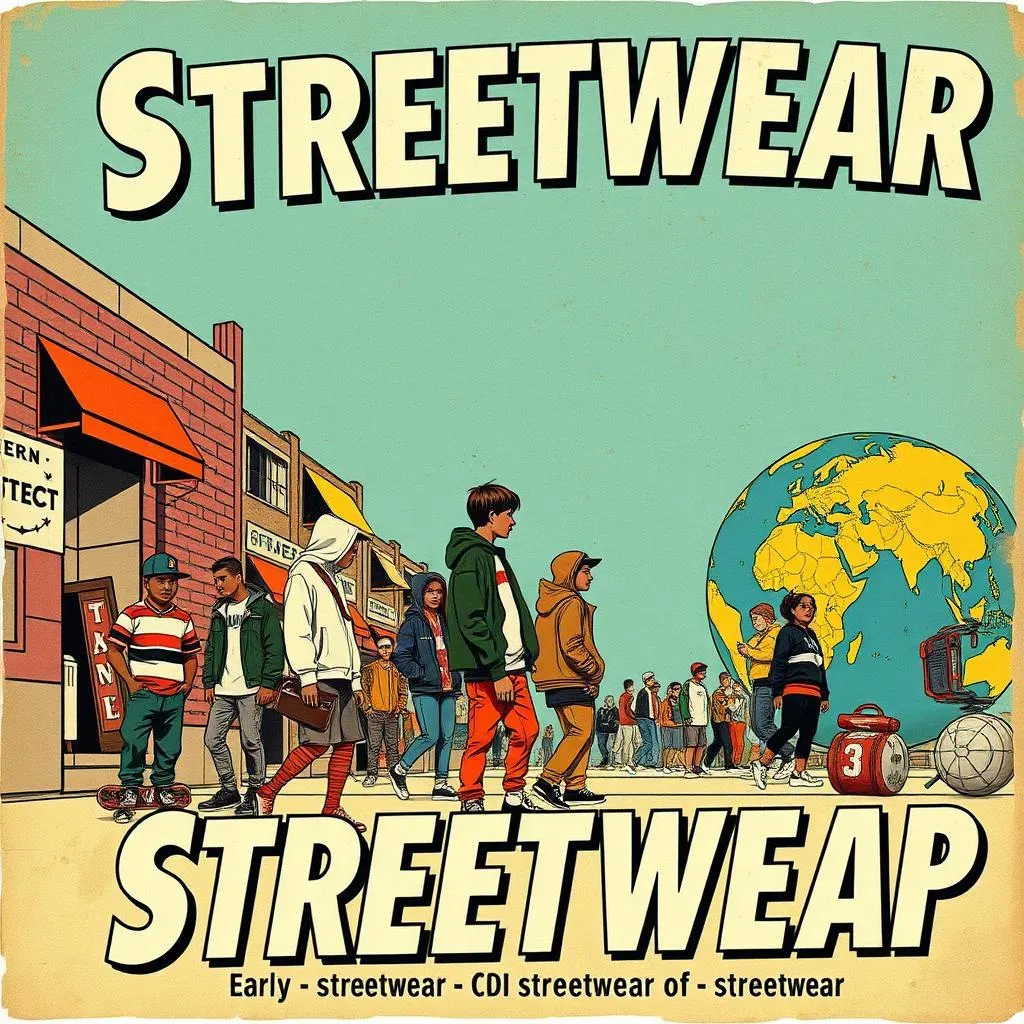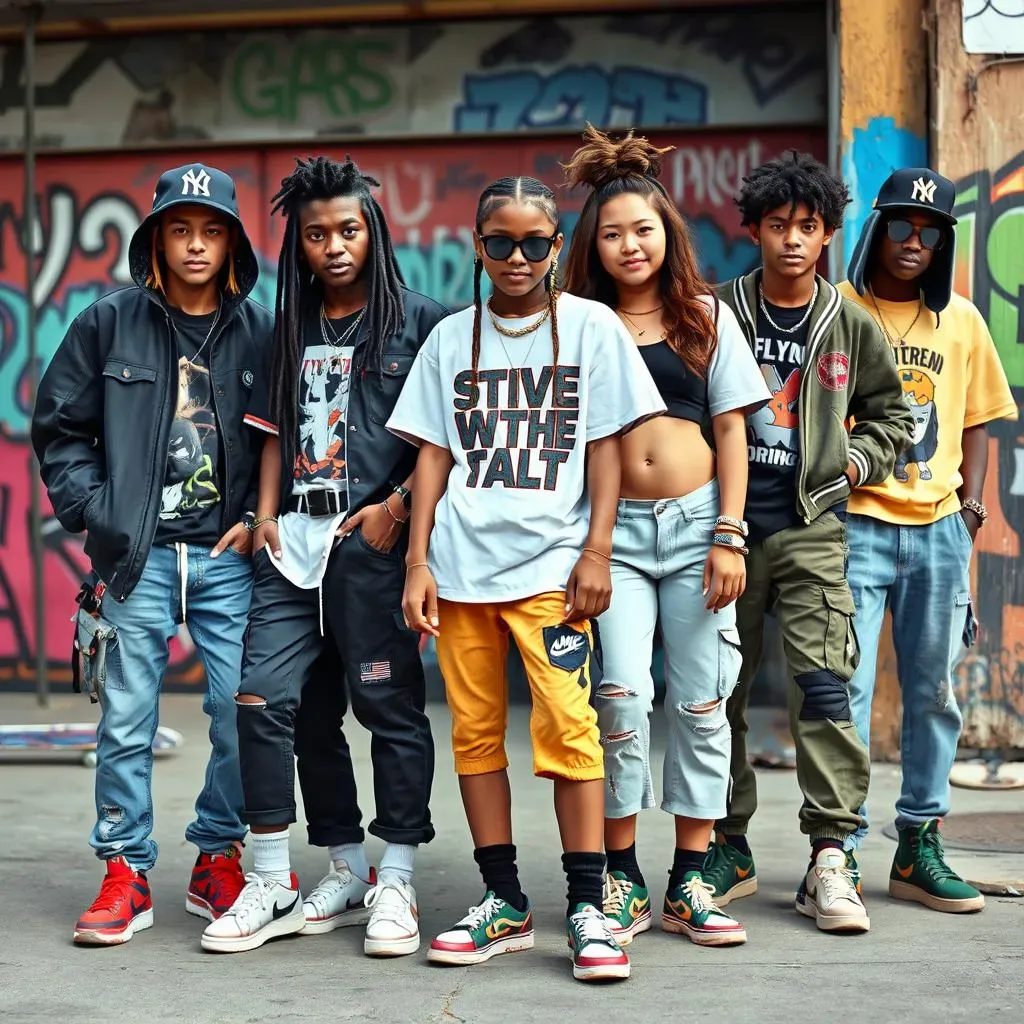Table of Contents
Ever wondered why we call it "streetwear"? It's a name that conjures images of cool kids, urban landscapes, and cutting-edge fashion. But the story behind this seemingly simple term is richer and more complex than you might think. This article explores the fascinating history and evolution of the name "streetwear," tracing its journey from underground subcultures to global phenomenon. We'll uncover the origins of the term, examining how it reflects the style's unique identity and its connection to street culture. We'll also dive into what defines streetwear today, considering why the name remains relevant despite the style's incredible growth and mainstream adoption. Get ready to unravel the mystery behind "why is it called streetwear?" and discover the unexpected story behind one of the most influential fashion movements of our time. Prepare to be surprised by the journey, from its humble beginnings to its current dominance in the fashion world. This isn't just about clothes; it's about culture, rebellion, and self-expression. Let's explore!
Streetwear's Roots: From the Streets to the Runway
Streetwear's Roots: From the Streets to the Runway
Streetwear's story isn't a neat, linear path; it's a vibrant tapestry woven from diverse threads of subcultures and social movements. Think about the hip-hop scene of the 1970s and 80s in New York City – breakdancers, graffiti artists, and DJs all contributed to a unique style that reflected their environments and attitudes. These weren't fashion shows; these were expressions of identity, born on the streets and infused with a rebellious spirit. Early streetwear wasn't about designer labels; it was about repurposing existing clothing, creating something new and personal. Think patched-up denim jackets, oversized jerseys, and custom sneakers – all reflecting a DIY ethos and a rejection of mainstream trends. This raw, authentic style, born from the streets, was the foundation upon which the modern streetwear industry was built.
This early streetwear wasn't just about clothes; it was about a whole attitude. It represented a counter-culture movement, a way for young people to express themselves outside of the confines of established fashion norms. Think about the impact of skateboarding culture – the loose, functional clothing that skaters wore became a style in its own right, influencing fashion trends for decades to come. This rebellious spirit, this DIY ethic, this focus on functionality and self-expression—these are the core elements that defined early streetwear, and they continue to influence its evolution today. Want to see some killer examples of early streetwear inspiration? Check out this article on Italian street style in the 80s: .
Era | Key Influences | Defining Characteristics |
|---|---|---|
1970s-80s | Hip-hop, skateboarding, graffiti art | DIY aesthetic, repurposed clothing, bold graphics |
The transition from the streets to the runway was gradual but significant. Brands like Stüssy, initially selling surf-inspired apparel, began to gain traction with a wider audience. This marked a shift—streetwear was no longer just about self-expression; it was becoming a recognizable and increasingly commercialized style. This evolution brought both opportunities and challenges, as the authenticity of streetwear became a subject of debate. The lines between underground culture and mainstream fashion began to blur, leading to both exciting collaborations and concerns about the dilution of the original ethos. This period saw the rise of influential figures like Shawn Stüssy, who helped bridge the gap between street culture and the broader fashion industry.
The rise of hip-hop further propelled streetwear into the mainstream. Rappers and other artists started wearing and endorsing brands, making streetwear a symbol of status and success. This increased visibility led to collaborations with high-fashion houses, further blurring the lines between street and high-end fashion. The fusion of these two seemingly disparate worlds created a unique dynamic, and ultimately changed the landscape of the fashion industry. To learn more about the impact of Italian street style on global fashion, see our guide on .
- Increased brand recognition
- Collaborations with high-fashion brands
- Rise of streetwear as a mainstream style
Why "Streetwear"? The Evolution of a Name
Why "Streetwear"? The Evolution of a Name
The Name's Humble Beginnings
So, why "streetwear"? It's pretty self-explanatory, isn't it? The name itself points to the style's origins: the streets. It wasn't a carefully crafted marketing term; it was a natural descriptor, reflecting the style's grassroots emergence from urban subcultures. Think about it – the term accurately captures the essence of the clothing's origins, its connection to a specific environment and attitude. It wasn't high fashion; it was the clothing of the streets, a style born from the ground up. This organic naming convention is part of what made early streetwear so compelling; it was authentic, it was real.
The term "streetwear" wasn't initially used as a formal category in fashion magazines; it evolved organically through word of mouth and the growing recognition of a distinct style. The name stuck because it resonated with the culture it represented. It's a perfect example of how a name can encapsulate a movement's essence. Early adopters and those involved in the culture simply used the term to refer to the specific clothes they were wearing and the communities they belonged to. It wasn't until later that brands and the fashion industry formalized the term, capitalizing on its existing recognition and cultural weight. For more on early brand recognition, check out this article on .
- Organic emergence from street culture
- Accurate reflection of style's origins
- Word-of-mouth spread and cultural recognition
From Underground to Mainstream: The Name's Evolution
As streetwear gained popularity, the term itself evolved. Initially, it was associated with specific subcultures like hip-hop and skateboarding, but as the style expanded, so did the definition of "streetwear." The term became more inclusive, encompassing a wider range of styles and influences. This evolution reflects the fluidity of street culture itself, constantly adapting and changing to reflect the ever-shifting social landscape. It's a testament to the style's ability to evolve and incorporate new trends while retaining its core identity.
The commercialization of streetwear further shaped the meaning of the term. As brands began to capitalize on the style's popularity, "streetwear" became a marketable category, used to sell products and build brand identities. This led to debates about authenticity and the dilution of the original ethos. However, the term itself remained, adapting to the evolving industry and its broader reach. This is why the question "why is it called streetwear?" is more complex than it initially seems. To understand the evolution of Italian streetwear, see this article on .
Phase | Defining Characteristics | Impact on the Name |
|---|---|---|
Early Adoption | Subcultural focus (hip-hop, skateboarding) | Specific and niche meaning |
Mainstream Adoption | Wider range of styles and influences | Broader, more inclusive definition |
Commercialization | Brand marketing and industry recognition | Marketable category |
The Name Today: A Reflection of Culture
Today, "streetwear" continues to evolve, encompassing a vast array of styles, designs, and influences. While the original meaning remains tied to its street origins, the term now represents a broader cultural phenomenon, a testament to the style’s enduring appeal and ability to adapt. The name "streetwear" itself has become synonymous with a particular aesthetic, a specific attitude, and a certain cultural identity. It's a shorthand for a complex and multifaceted style, one that defies easy categorization but maintains a clear connection to its roots.
The enduring power of the name "streetwear" lies in its ability to capture the essence of a global phenomenon that continues to evolve and inspire. While the lines between high fashion and street style have become increasingly blurred, the term still resonates with its original meaning, acting as a reminder of the style's humble beginnings and the rebellious spirit that continues to inform its evolution. The term remains a powerful symbol of self-expression, creativity, and the ongoing dialogue between fashion and culture. For more on the latest trends, check out this article on .
Beyond the Label: Defining Streetwear's Identity
Beyond the Label: Defining Streetwear's Identity
Beyond the Label: Defining Streetwear's Identity
So, what truly *is* streetwear? It's more than just trendy clothes; it's a complex mix of style, attitude, and cultural influence. It's about self-expression, rebellion, and pushing boundaries. Think of it like a constantly evolving language, spoken through clothing. The clothes themselves are only part of the story. It's about the way people wear them, the communities they create, and the messages they convey. It's a blend of high fashion and subculture, a dynamic tension between the established and the experimental. Streetwear isn't confined to a single style; it's a melting pot of influences, constantly reimagining itself.
Consider the role of music, art, and social movements. Hip-hop, skateboarding, and graffiti art have all profoundly shaped streetwear's evolution. Each subculture contributed its unique aesthetic, infusing the style with a rebellious spirit and a DIY ethos. These influences aren't just visual; they represent a whole attitude, a rejection of mainstream norms, and a celebration of individuality. This is why understanding streetwear requires looking beyond the clothes themselves and exploring the rich cultural tapestry from which it emerged. For a deeper dive into Italian streetwear's impact, check out this guide on Italian streetwear trends.
- Self-expression and individuality
- Rebellion against mainstream fashion
- Fusion of high fashion and subcultures
Streetwear's Evolving Identity: More Than Just Clothes
One of the most interesting aspects of streetwear is its ability to constantly reinvent itself. It’s not static; it's a living, breathing thing that evolves with the times, reflecting changing trends, cultural shifts, and technological advancements. What was considered cutting-edge a decade ago might seem dated today, highlighting the style's dynamic nature. This constant evolution is what keeps streetwear exciting and relevant, making it a constantly evolving conversation between designers, consumers, and culture. It's a reflection of our times, a snapshot of the current cultural landscape.
This fluidity also makes defining streetwear challenging. There's no single, definitive style guide; instead, it's characterized by a sense of innovation, a willingness to experiment, and a continuous push for originality. This is why the term "streetwear" itself is constantly being redefined and reinterpreted. It’s a conversation, not a fixed definition. It's a testament to the style's adaptability and its ability to remain relevant, despite the ever-changing trends. This is why understanding the evolution of Italian street style is so important. Learn more about Italian street style in Rome.
Aspect | Description | Impact on Identity |
|---|---|---|
Constant Evolution | Adapting to trends and cultural shifts | Dynamic and ever-changing |
Innovation and Experimentation | Pushing boundaries and challenging norms | Unique and expressive |
Cultural Relevance | Reflecting current social and artistic movements | Meaningful and significant |
Streetwear Today: Why the Name Still Matters
Streetwear Today: Why the Name Still Matters
The Enduring Appeal of "Streetwear"
Even today, "streetwear" remains a powerful label. It signifies more than just clothing; it embodies a cultural movement, a rejection of conformity, and a celebration of individuality. The name itself continues to resonate because it accurately reflects the style's roots—the streets—and its connection to counter-culture movements. It's a shorthand for a complex and multifaceted style, one that transcends fleeting trends and speaks to a deeper sense of identity. This enduring appeal is why the term continues to be used, even as the style itself has evolved and expanded. The name evokes a sense of authenticity, a connection to the underground, and a rebellious spirit that continues to attract a global following. For more on current trends, check out this article on Italian streetwear for women.
The continued use of the term "streetwear" also highlights its success in the fashion industry. Despite its humble beginnings, the style has become a major force in global fashion, influencing high-end designers and mainstream brands alike. This mainstream adoption hasn't diluted the term's meaning; instead, it has broadened its reach, making it accessible to a wider audience while retaining its connection to its original subcultures. The name continues to be a potent marketing tool, appealing to consumers who identify with the style's rebellious spirit and its connection to street culture. This makes "streetwear" more than just a label; it's a brand, a lifestyle, and a cultural phenomenon.
- Connection to street culture and subcultures
- Symbol of rebellion and individuality
- Successful marketing tool in the fashion industry
The Evolution of the Term: Adaptability and Relevance
The term "streetwear" has proven remarkably adaptable. As the style itself has evolved, so too has the meaning and application of the name. It's no longer solely associated with specific subcultures; instead, it encompasses a broader range of styles and influences, reflecting the ever-changing nature of street culture. This adaptability is a testament to the term's power and its ability to remain relevant in a constantly shifting fashion landscape. The name's flexibility allows it to encompass new trends and innovations while retaining its core identity, ensuring its continued use and relevance.
The ongoing debate about authenticity within streetwear further underscores the term's significance. As the style has become increasingly commercialized, questions have arisen about its true meaning and its connection to its original roots. This ongoing discussion highlights the importance of the term "streetwear" and its role in shaping the identity and perception of the style. The term itself becomes a focal point in conversations about authenticity, commercialization, and the relationship between fashion, culture, and identity. To learn more about the authenticity debate, check out this article on Italian street style in Rome.
Aspect | Impact on the Term |
|---|---|
Adaptability | Broadened meaning and application |
Commercialization | Increased visibility and mainstream adoption |
Authenticity Debate | Focus on the term's evolving meaning and cultural significance |
Streetwear's Future: A Name That Endures
Looking ahead, the term "streetwear" is likely to continue evolving, reflecting the ever-changing dynamics of fashion and culture. Its enduring appeal lies in its ability to represent both tradition and innovation, rebellion and acceptance, authenticity and commercialization. The name serves as a constant reminder of the style's origins while simultaneously embracing its ongoing transformation. The term will likely continue to be used, adapting to new trends and influences while retaining its core identity.
Ultimately, "streetwear" transcends a simple label; it's a cultural phenomenon, a testament to the power of self-expression and the enduring influence of street culture. The name itself continues to serve as a powerful symbol of this movement, linking past, present, and future through a shared aesthetic, attitude, and identity. The term's longevity and adaptability guarantee its continued relevance in the ever-evolving world of fashion. For a deeper dive into Italian streetwear's evolution, explore this guide on Italian streetwear trends for 2024.